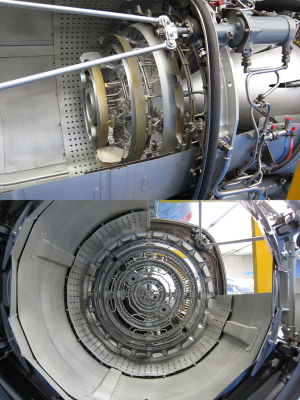Well, let's start with
1st things 1st - What is Jet Engine, what's different, its basic parts & types.
Low IQ noob like me will use Google search incl. Wiki obviously.
Others are also expected to contribute - Youtube videos, 3D anim, etc.
I'm not going to get into history & making process, etc. Just straight to point, simple, high school level, compact yet comprehensive.
(
https://en.wikipedia.org/wiki/Jet_engine)
A jet engine is a type of
reaction engine,
discharging a fast-moving jet of heated gas (usually air) that generates thrust by jet propulsion.
The term jet engine typically refers to an internal combustion air-breathing jet engine such as a turbojet, turbofan, ramjet, pulse jet, or scramjet. In general, jet engines are internal combustion engines.
Air-breathing jet engines typically feature a
rotating air compressor powered by a turbine, with the leftover power providing thrust through the propelling nozzle—this process is known as the
Brayton thermodynamic cycle.
What is Action-Reaction engine
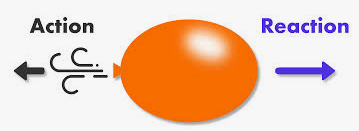
action=

reaction=




 What is different?
What is different?
Basic working principle is same like in a 4-stroke Internal Combustione Engine, the fuel is fossil fuel derived.
In ICE the compressed, ignited & expanded fuel+air mix pushes the piston connected to shaft & then to drive wheels through gears. So some of the fuel's heat+KE is transferred to piston, remaining fuel is ejected as waste through Silencer pipe.
In GTE, the compressed, ignited, expanded fuel+air mix pushes the angled turbine blades causing their rotation & in turn rotating the compressors/intake-fans also on the same shaft which pull in more air causing a cycle. So some heat+KE of fuel is transferred to turbine+shaft+compressors, rest is exhausted producing thrust which is Action & in Reaction the Aircraft moves forward.
 CAUTION - 60/40% is a notional figure, not always the case. It depends on engine type, characrteristics.
CAUTION - 60/40% is a notional figure, not always the case. It depends on engine type, characrteristics.
Jet engine sections & basic parts
As example, a Turbojet is used below.
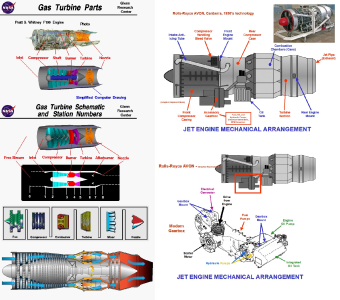 NOTE- the speed of air in any engine, Civil/Military, Turbo-jet/fan, before entering engine has to be subsonic otherwise the shonic shockwaves will rupture the engine.
NOTE- the speed of air in any engine, Civil/Military, Turbo-jet/fan, before entering engine has to be subsonic otherwise the shonic shockwaves will rupture the engine.
In Civil jets the aircraft speed is always subsonic, hence the inlet with front fanis visible.
In military jets the inlet has a tunnel designed to reduce the speed of air at supersonic airframe speed.
The
Compressors then compress the incoming air by say 10/20/30 times, measured in terms of
Compression ratio or OPR (Overall Pressure Ratio). compressing the air also increases its temperature. The compressed air can be bleeded via plumbing, hence called
BLEED AIR to be used for HVAC, anti-ice, engine cooling, compartment pressurization, ECS (Environment Control System), thrust control, hetc.
The
Combustor injects fuel & mixes with air in a
Fuel-Air mix ratio, ignites the mix, which expands the gas towards Turbines.
The
Turbine blades are angled to get pushed by air & rotate, in turn rotating the fans, compressors.
The temperature measured just before turbine blades is known as
Turbine Inlet Temperature, limited by melting point of body materials
.
Nozzle has evolved from a typical short exhaust to modern ones with stealth features to reduce RCS, IRS & acoustic signature. pressure can be measured at nozzle w.r.t. intake pressure, called
EPR (Engine Pressure Ratio).
The
Gear Box in a jet engine is called
Accessory Drive(AD), have 2 parts -
EMAD (Engine Mounted Accessory Drive) &
AMAD (Airframe Mounted Accessory Drive). AD is connected to turbines which allows initial rotation for start & then take-off the power to
electricity generators, etc.
The central rotating parts are fans, compressors, turbines on a shaft, comprise a
SPOOL.
The outer stationary parts are inlet vanes, exhaust vanes, combustors, casings, AD.
 Jet Engine types
Jet Engine types
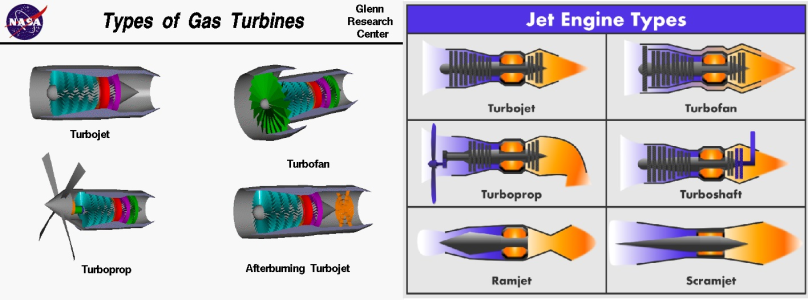
Today's popular frontline fighter jets have Turbofans.
Difference b/w Turbojet & Turbofan -
In
Turbojet, 100% of the air pulled into engine is compressed burned in combustor & exhausted.
All rotating components consitute a
single SPOOL.
In
Turbofan,
certain % of air pulled in is less compressed &
BYPASSED off the combustor & may or may not be mixed back in core exhaust by Mixer, before exiting the nozzle. But for understanding we can imagine that the cylindrical core exhaust air will be surrounded by outer cylinderical bypassed air. The bypassed air can be used for engine cooling, increased thrust, etc.
So basically a Turbojet is surrounded by a cylndrical structure to create channel for bypassed air & diameter of some frontmost stages of fan are extended.
All the portions which interact with non-bypassed combusted air constitute
engine CORE.
The
bypass ratio (BPR) of a turbofan engine is the ratio between the mass flow rate of the bypass stream to the mass flow rate entering the core. A
bypass ratio of 6, for example, means that 6 times more air passes through the bypass duct than the amount that passes through the combustion chamber. A
Bypass ratio of 0.6 means 60% equivalent of combusted core air, is bypassed.
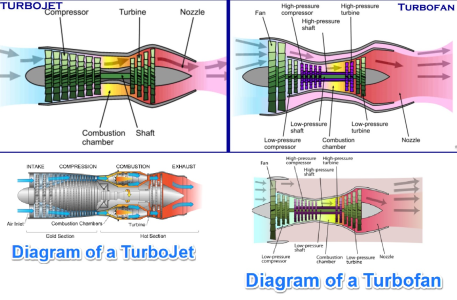
We see difference in 2 examples of Turbofan -
In above example the bypassed air is mixed within the nozzle, a typical example of military jet engine.
In below example the bypassed air is released far before, a typical example of passenger/cargo jet engine.
NOTE - in any type of engine the
tangential velocity of any stage of blade tip cannot cross Mach-1 or Supersonic. So the
blades with lesser diameter can spin faster than those with higher diameter. The inlet fan(s) & rearmost turbine blades diameter is highest & hence need to be on a
separate concentric shaft. This creates
2 SPOOLS.
HP(High Presure) SPOOL spinning faster comprises HPC (High Pressure Compressors), HPT (High Pressure Turbine(s)).
LP(Low Pressure) SPOOL spinning slower comprises fan(s), LPC (Low Pressure Compressors), LPT (Low Pressure Turbine(s)).
The # of stages of fans, LPC, HPC, HPT, LPT differ in different engine models.
Most military combat jet's engines have
AFTERBURNER or REHEAT or AUGMENTOR.
As is the name : After-Burner or Re-Heat, it is
positioned after the burner/combustor, even after the Turbines, is used to again
re-heat the exhaust gas with more fuel spray, creating 30-70% more thrust beyond 100% throttle power. It can kick up the
max speed to 1.5-2 times than at 100% power depending upon altitude & payload. It
rapidly depletes fuel hence used mainly during dogfight, launching weapon, intercepting, evasion.
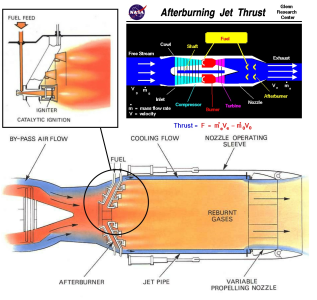
IDK if all engines have an outer channel for cooling by bypass air. Belowis a sample pic.
